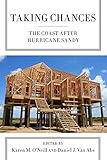Taking Chances : The Coast after Hurricane Sandy / ed. by Karen M. O'Neill, Daniel J. Van Abs.
Material type: TextPublisher: New Brunswick, NJ : Rutgers University Press, [2016]Copyright date: ©2016Description: 1 online resource (304 p.) : 10 photographs, 14 maps, 11 fiContent type:
TextPublisher: New Brunswick, NJ : Rutgers University Press, [2016]Copyright date: ©2016Description: 1 online resource (304 p.) : 10 photographs, 14 maps, 11 fiContent type: - 9780813573793
- 333.9100974 23
- QH104.5.A84
- online - DeGruyter
| Item type | Current library | Call number | URL | Status | Notes | Barcode | |
|---|---|---|---|---|---|---|---|
 eBook
eBook
|
Biblioteca "Angelicum" Pont. Univ. S.Tommaso d'Aquino Nuvola online | online - DeGruyter (Browse shelf(Opens below)) | Online access | Not for loan (Accesso limitato) | Accesso per gli utenti autorizzati / Access for authorized users | (dgr)9780813573793 |
Frontmatter -- CONTENTS -- ACKNOWLEDGMENTS -- Introduction: A Transformational Event, Just Another Storm, or Something in Between? -- Part I: The Storm -- 1. Hurricane Sandy from Meteorological and Climatological Perspectives -- 2. A Tough Move to Make: Lessons Learned from Emergency Evacuations in Coastal Connecticut during Hurricane Sandy -- Part II. THE DAYS AFTER THE STORM -- 3. Overlooked Impacts of Hurricane Sandy in the Caribbean -- 4. Polling Post-Hurricane Sandy: The Transformative Personal and Political Impact of the Hurricane in New Jersey -- 5. Ecological Injury and Responses to Hurricane Sandy: Physical Damage, Avian and Food Web Responses, and Anthropogenic Attempts to Aid Ecosystem Recovery in New Jersey Estuaries -- 6. Surviving Sandy: Identity and Cultural Resilience in a New Jersey Fishing Community -- Part III. PLANNING FOR CHANGE? -- 7. Green Gentrification and Hurricane Sandy: The Resilience of the Green Growth Machine around Brooklyn’s Gowanus Canal -- 8. Boardwalks Reborn: Disaster and Renewal on the Jersey Shore -- 9. A Sure/Shore Thing? Tourism Recovery in New York and New Jersey after Hurricane Sandy -- 10. Local Fiscal Impacts of Hurricane Sandy -- 11. Local Responses to Hurricane Sandy: Heterogeneous Experiences and Mismatches with Federal Policy -- 12. Water Utilities: Storm Preparedness and Restoration -- 13. Impact of Extreme Events on the Electric Power Sector: Challenges, Vulnerabilities, Institutional Responses, and Planning Implications from Hurricane Sandy -- Conclusion: Emerging Responses to Life on the Urbanized Coast after Hurricane Sandy -- NOTES ON CONTRIBUTORS -- INDEX
restricted access online access with authorization star
http://purl.org/coar/access_right/c_16ec
Humanity is deeply committed to living along the world’s shores, but a catastrophic storm like Sandy—which took hundreds of lives and caused many billions of dollars in damages—shines a bright light at how costly and vulnerable life on a shoreline can be. Taking Chances offers a wide-ranging exploration of the diverse challenges of Sandy and asks if this massive event will really change how coastal living and development is managed. Bringing together leading researchers—including biologists, urban planners, utilities experts, and climatologists, among others—Taking Chances illuminates reactions to the dangers revealed by Sandy. Focusing on New Jersey, New York, and other hard-hit areas, the contributors explore whether Hurricane Sandy has indeed transformed our perceptions of coastal hazards, if we have made radically new plans in response to Sandy, and what we think should be done over the long run to improve coastal resilience. Surprisingly, one essay notes that while a large majority of New Jerseyans identified Sandy with climate change and favored carefully assessing the likelihood of damage from future storms before rebuilding the Shore, their political leaders quickly poured millions into reconstruction. Indeed, much here is disquieting. One contributor points out that investors scared off from further investments on the shore are quickly replaced by new investors, sustaining or increasing the overall human exposure to risk. Likewise, a study of the Gowanus Canal area of Brooklyn shows that, even after Sandy swamped the area with toxic flood waters, plans to convert abandoned industrial lots around the canal into high-density condominiums went on undeterred. By contrast, utilities, emergency officials, and others who routinely make long-term plans have changed operations in response to the storm, and provide examples of adaptation in the face of climate change. Will Sandy be a tipping point in coastal policy debates—or simply dismissed as a once-in-a-century anomaly? This thought-provoking collection of essays in Taking Chances makes an important contribution to this debate.
Mode of access: Internet via World Wide Web.
In English.
Description based on online resource; title from PDF title page (publisher's Web site, viewed 02. Jun 2024)


